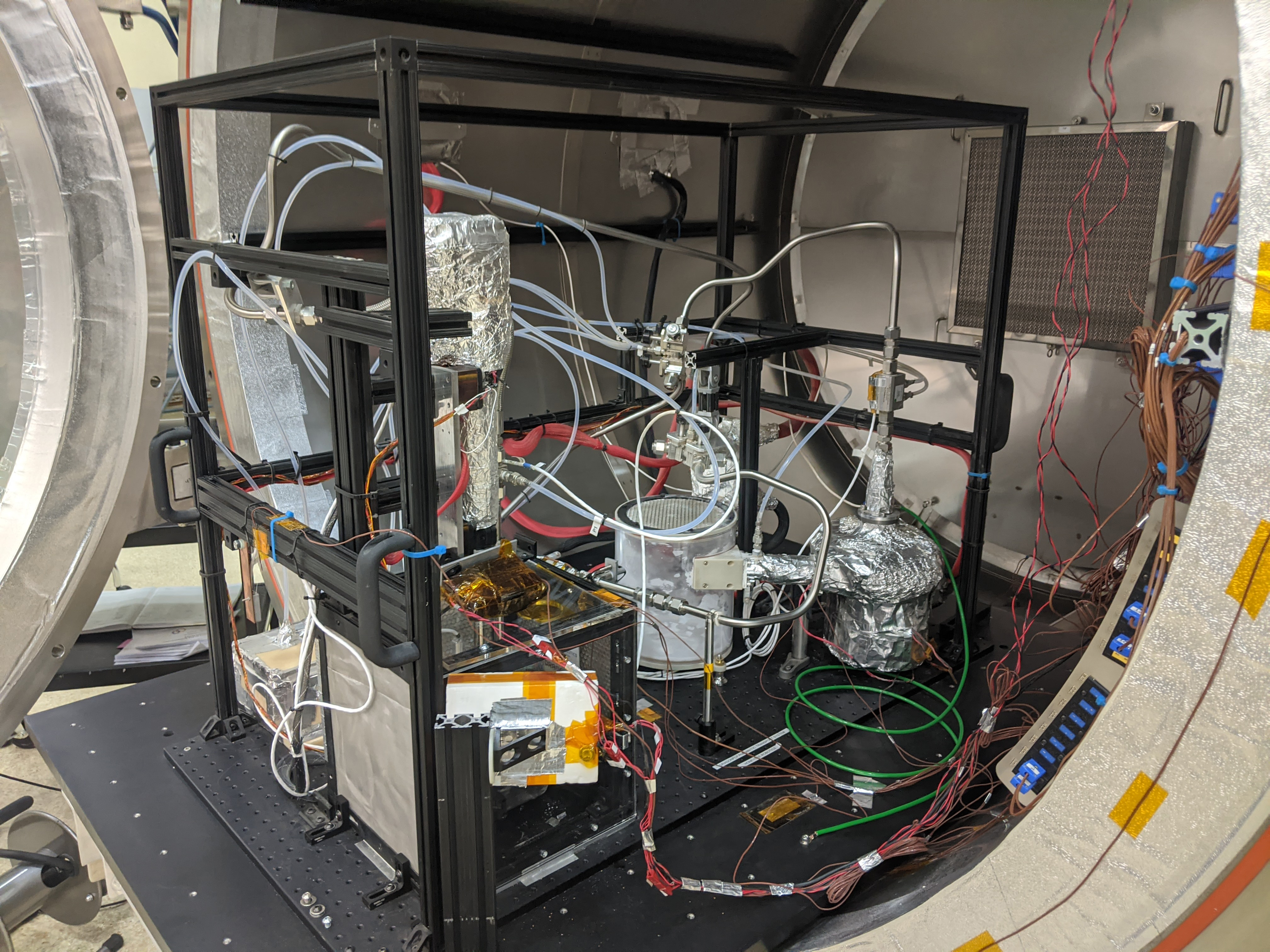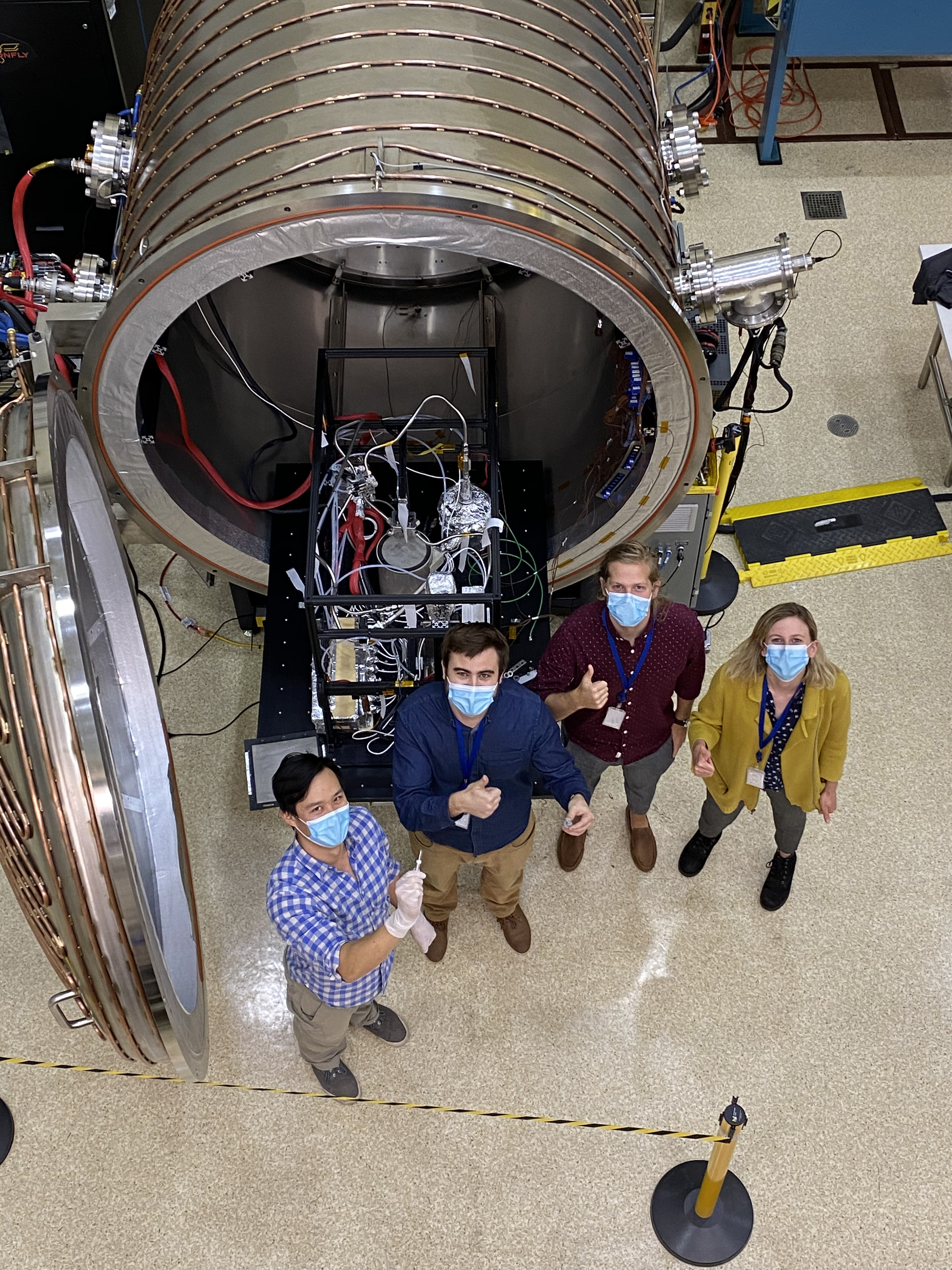From the Flight Line
Insights on Dragonfly's Development from the Mission Team
February 25, 2021
New Chamber Gives Dragonfly Sampling System a 'Taste' of Titan
Dragonfly's DrACO system was put to test in APL's brand new, state-of-the-art Titan chamber.
By Joey Sparta

The Dragonfly Pneumatic Transfer System prototype stands inside the 5-foot diameter Titan chamber at the Johns Hopkins Applied Physics Laboratory in Laurel, Maryland. The system robotically collects samples using the power of gas driven by an air blower (back right). Engineers must demonstrate that the hardware can operate successfully in the Titan chamber's extreme conditions of minus 294 °F (minus 181 °C) and 1.5 times the atmospheric pressure on Earth. Image Credit: Honeybee Robotics
Dragonfly – NASA's mission to send a rotorcraft-lander to explore Saturn's moon Titan – will take advantage of Titan's dense atmosphere to vacuum-up samples from the surface and deliver them to science instrumentation onboard. This task is performed by the Pneumatic Transfer Subsystem within Dragonfly's sampling system – DrACO – Drill for Acquisition of Complex Organics, built by Honeybee Robotics of Altadena, California.
Combined with two sample acquisition drills and a sample-delivery carousel, DrACO robotically samples and delivers Titan surface material to Dragonfly's onboard mass spectrometer for chemical analysis. Pneumatic transfer, or using atmospheric gases to transport material, is not new technology – just take a look at your household vacuum cleaner. Dragonfly plans to collect samples on Titan in the same way a vacuum removes dirt from carpet: a high-speed pump (or blower) suctions the air, picks up loose particles from the surface, carries them through some tubing, and deposits them into a container (in this case, a sample cup). The concept is well-suited for Dragonfly due to Titan's dense atmosphere and low gravity, but it's the ability for pneumatic transfer to handle potentially sticky materials on Titan's surface that sets it apart from other robotic handling methods like scoops and augers.
However, while vacuum pumps are commonly used to transfer material on Earth, they have never been used to collect samples on a space mission ... yet.
The Dragonfly team has recently tested the concept with a high-fidelity prototype of the DrACO pneumatic sampling system in the Titan Pressure Environment Chamber (TPEC), a brand-new, state-of-the-art chamber that was custom-built for the Dragonfly mission at the Johns Hopkins Applied Physics Laboratory in Laurel, Maryland. Inside the 5-foot diameter, 8-foot long chamber, the air pressure is 1.5 times the pressure of standard atmospheric air on Earth, and temperatures are a bone-chilling minus 294 °F (minus 181 °C). The TPEC is a proving ground for Dragonfly's many instruments and subsystems before final design and, eventually, launch in 2027.
In early November 2020, our team at Honeybee Robotics arrived at APL to kick off a three-week test campaign of the Pneumatic Transfer System prototype in the TPEC. The prototype successfully demonstrated sample transfer with a variety of simulated Titan materials under both ideal and difficult conditions (such as a clogged tube). In addition, the blower's performance remained strong even after it ingested twice the total volume of abrasive particles expected during the entire lifetime of the Dragonfly mission (3.3 years of operation on Titan's surface).
The success of this test clears a major hurdle for DrACO, demonstrating that our pneumatic sampling technology can meet the challenges of Titan's extreme environment. A large number of dedicated individuals came together for this achievement, including APL staff who helped support the TPEC tests, Barber-Nichols in its partnership with Honeybee Robotics in developing and delivering the prototype blower, and the DrACO and Dragonfly mission leads at NASA Goddard Space Flight Center and APL.
Joey Sparta is a robotics engineer and the design lead for the Pneumatic Transfer System at Honeybee Robotics. A member of the Dragonfly team since 2018, he has helped develop the DrACO sampling system through design, analytical modeling, prototyping and testing.

Members of the DrACO Dragonfly sampling system testing team hold up the first sample successfully captured in Titan conditions. From left are Bobby Wei, pneumatic transfer system, lead system engineer; Joey Sparta, pneumatic transfer system, lead design engineer; Andrew Bocklund, mechanical engineer; and Lilly Ware, electrical engineer. Behind the team is the Dragonfly pneumatic transfer system prototype and the Titan chamber at APL. Image Credit: Honeybee Robotics

Joey Sparta and Andrew Bocklund of Honeybee Robotics execute test procedures and monitor system telemetry near the TPEC chamber at APL. Image Credit: Honeybee Robotics


